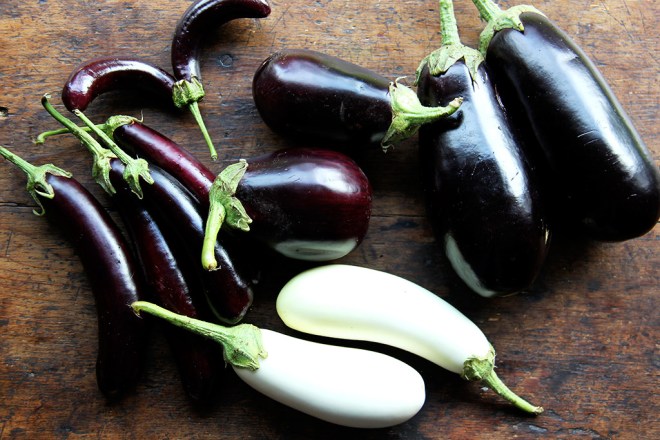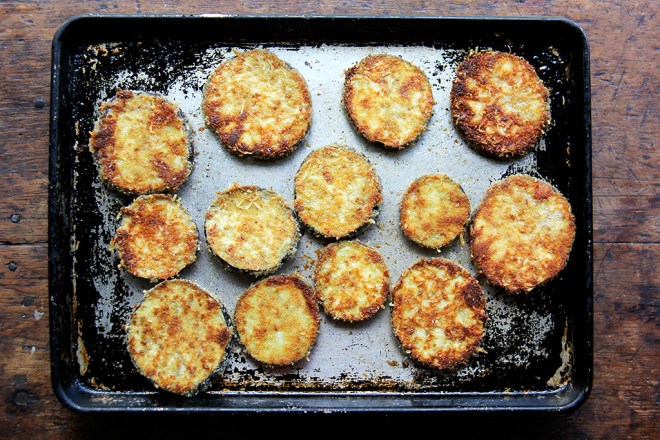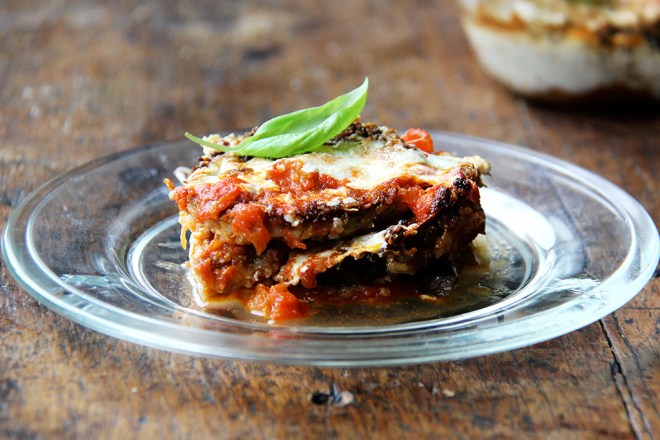It’s the season of overflowing market bags, heavy CSA boxes, and gardens run amok. Alexandra Stafford of Alexandra Cooks is showing us how to store, prep, and make the most of the bounty, without wasting a scrap.
Is there a vegetable more polarizing than eggplant? More capable of inciting disputes over its preparation? More likely to cause adults and children alike to scrunch their faces in disgust?
Never have I heard or read more contradictory commands about how something should be treated. NEVER salt. ALWAYS salt. NEVER fry. ALWAYS fry. NEVER peel. ALWAYS peel.

Alexandra Stafford
Because eggplant can be anything from bitter and greasy to meaty and rich, people seem to either hate or love this late-summer vegetable (actually a fruit, a member of the controversial nightshade family). And while I have no doubt that some people genuinely dislike eggplant, I fear that others may have written it off years ago when they were, say, 8, or maybe after a bad experience with oil-laden eggplant parm, and they haven’t given it a chance since. And this is a shame, because how eggplant tastes is directly related to how it is prepared, and when it is treated properly, it tastes sweet and mild and not a bit bitter or oily.
Certain preparations, in fact, need little or no oil at all. When roasted or charred, for instance, an eggplant’s skin will blacken, leaving its flesh creamy and scoopable, a near-purée ready to be mixed with minced garlic, a splash of vinegar, and lots of chopped herbs. When sliced into rounds or halved and grilled, the meat softens and assumes a smokiness, a perfect base for a smear of tangy miso sauce or a drizzle of salsa verde. And when thinly sliced and layered into a gratin with tomatoes and onions, it melts into silky, fork-tender rounds.
It’s when oil is introduced to the preparations that the trouble begins. Eggplant is a sponge and, given the opportunity, will soak up any oil in reach, which is why sautéing and deep-frying can leave it tasting heavy and greasy. Salting leaches out moisture and condenses the flesh, reducing its tendency to absorb and helping it stay crisp and light. This, I learned from The America’s Test Kitchen Family Cookbook, is an important step toward making a good eggplant parmesan. But the real key to achieving eggplant parmesan success is skipping the stovetop, frying-in-batches method altogether. America’s Test Kitchen’s method calls for baking the breaded eggplant on two preheated baking sheets, a step that not only saves time but also produces eggplant with superior taste and texture, emerging from the oven evenly golden without a hint of greasiness.
These light, crisp rounds are irresistible, which will tempt you to stop right there, pile them onto a platter, sprinkle them with basil, pass some sauce on the side, and call your efforts done. But pushing on with this labor of love has a reward, too: a bubbling, comforting casserole layered with late-summer flavors that just might unite eggplant haters and evangelists alike around your table.

Alexandra Stafford
To store your eggplant:
- If your kitchen is cool enough, you can store unwashed eggplant out of the fridge on your countertop for two to three days. Eggplant is best eaten within a few days of being picked and purchased, but if you will not be eating it in the short term, store the eggplant in the fridge — as with tomatoes and peppers, the cool temperature of a refrigerator is not ideal for preserving flavor and texture, but it will slow the eggplant’s deterioration.
To prep your eggplant:
- Trim off the green cap and stem. Peeling eggplant is most often unnecessary, though if a recipe (for, say, a soup or purée) calls for it, use a peeler or paring knife.
- Eggplant can be cooked in so many ways — roasted, grilled, sautéed, braised, deep-fried, microwaved — and depending on how you cook it, you may or may not want or need to salt it. Generally, when roasting, grilling, or braising, salting is unnecessary. Because eggplant will act like a sponge when given the chance, however, salting is a good idea before any type of frying. Salting removes moisture (and apparently any bitterness) and condenses the flesh so that it is less likely to soak up oil when it is sautéed or deep-fried.
To cook your eggplant:
- There are a few dishes that come to mind at the thought of eggplant: ratatouille, baba ganoush, caponata, pasta alla Norma, and of course, eggplant parmesan.
- Eggplant pairs well with many Mediterranean, Middle Eastern, and Asian flavors, and as noted above, can be cooked in so many different ways — more on a few of them below.
- Roasted: Eggplant can be roasted whole at 400 degrees F or so until it nearly collapses, about 30 or 40 minutes. The flesh then can be used as a spread or dip or as the base of a soup, stew, or croquette. Eggplant can also be diced or sliced or cut into wedges, tossed with olive oil and salt, and roasted until tender (25 minutes or so). Serve the roasted eggplant on its own or as part of an antipasto platter, fold it into pastas, layer it over pizza dough or in a vegetable tart, or toss it with other roasted vegetables and serve it as a salad.
- Halved eggplant can be stuffed with ground meats or rice or other grains and vegetables and roasted until everything is cooked through.
- Thin slices of eggplant can be layered with onions and tomatoes and baked into a gratin.
- Eggplant can be grilled whole until its skin completely blackens. When the skin is removed, the flesh will be soft and creamy but will taste smoky and can be mixed with garlic, herbs, oils, yogurt, and tahini for a dip or spread, or can be puréed with broth and used as the base of a soup.
- Eggplant can be sliced into rounds or, if small and slender like Japanese eggplant, halved lengthwise, and grilled. Toss pieces with olive oil and salt and pepper before grilling. Serve with salsa verde or chermoula or a smear of miso sauce: a mix of miso, sugar, rice wine, and sesame oil.
- Eggplant can be diced and pan-fried until golden and used in countless ways, namely in a hearty vegetarian sauce. Eggplant rounds can be tempura battered and deep-fried — the Japanese variety is particularly good for this. Lengthwise-sliced eggplant pieces can be pan-fried (or grilled or roasted or broiled), stuffed with ricotta or other cheeses, rolled, and baked into involtini with tomato sauce.
- Halved Chinese (or any long, slender variety) eggplants can be marinated and microwaved until tender.
- Finally eggplant, like so many vegetables, can be pickled.

Alexandra Stafford
Eggplant Parmesan
See the full recipe (and save and print it) here.
Serves 8 to 10
2
globe eggplants, about 2 pounds total, sliced into 1/4- to 1/2-inch thick rounds
Kosher salt
1
cup flour
Pepper
4 eggs
4
cups dried breadcrumbs, preferably homemade, or panko would be fine
3
ounces Parmesan cheese, grated (about 1 1/2 cups)
6
tablespoons olive oil
4
cups tomato sauce, preferably homemade
8
ounces mozzarella, grated, to yield 2 cups
Fresh basil, optional



